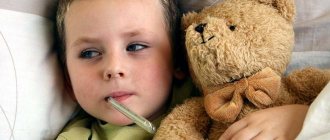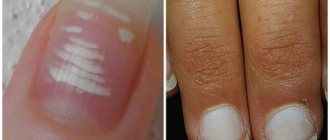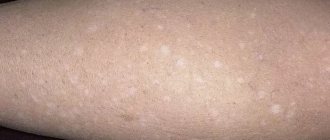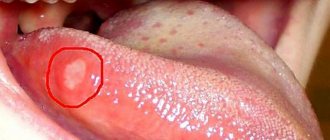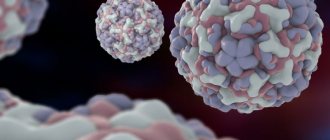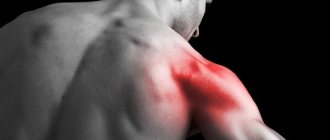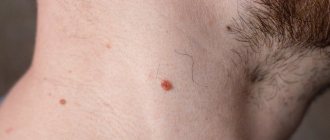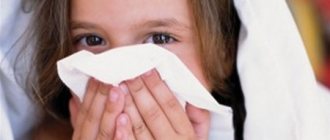Human skin can be called an indicator of health. This is especially true for a small child, whose skin is very sensitive to any changes - both in external conditions and in the general condition of the internal organs and systems of the body.
Skin rashes can be of different types. Some of them are not dangerous, others are a signal of the development of an allergic, infectious or autoimmune process. You cannot ignore a rash in a child or treat it yourself without finding out the root cause.
Skin rashes are a very common occurrence in young children.
Types of rashes in babies
In dermatology, there are three large groups into which all possible skin rashes in infants are divided:
- Physiological. This type of rash occurs in newborns. Rashes appear on the body as a result of hormonal changes occurring in the body.
- Immunological. It is a consequence of exposure to various irritating factors on the epidermis, such as allergens, temperature or friction. Such rashes include urticaria, prickly heat, an allergic reaction, or atopic dermatitis. Violation of basic hygiene rules can also lead to unwanted manifestations.
- Infectious. A rash is a symptom that accompanies a certain infectious (viral) disease, for example, chicken pox or scarlet fever (more details in the article: how is an infectious rash in children with viral exanthema treated?).
Rubella
A child may develop fever and rash when rubella develops. Its difference from chickenpox is that the rash is smaller and less extensive, which is mainly localized in the abdomen, back and face. Before the rash appears, certain signs that are similar to acute diseases of viral origin make themselves known:
- deterioration in general health;
- decreased or loss of appetite;
- the appearance of body aches;
- copious nasal discharge;
- increasing temperature values to high levels.
High temperatures last only until the rash appears. Then only a rash remains after the fever .
Treatment consists of bed rest and drinking plenty of water. The duration of rubella does not exceed a week.
Causes of rashes
There are many reasons why rashes may appear on the head, face, arms, legs, sternum, back or back of the head. The most likely are:
- Viral diseases. These include measles, rubella, chickenpox, and mononucleosis.
- Diseases of bacterial etiology. For example, scarlet fever.
- Allergy. Food products, hygiene products, clothing, household chemicals, perfumes and cosmetics, and insect bites can cause an allergic reaction.
- Mechanical damage to the epidermis. If the wound is treated insufficiently, irritation of the skin around it may begin, manifested in the form of pimples, white spots, colorless blisters, goosebumps, red or pink spots.
- Problems with blood clotting. In this situation, the rash consists of small hemorrhages characteristic of meningococcal meningitis.
So, rashes in babies come in different types and have different etiologies. It is not worthwhile to independently diagnose and determine the type of rash using photos from the Internet, even with good explanations. This should be done by a specialist.
Allergy
Allergic reactions are most common in children of the younger and middle age groups, whose bodies have not fully adapted to all foods. A lack of sense of proportion also plays a role, which is why the child eats my sweets. Allergies can be caused by wearing clothes made of synthetic material or detergents. The signs are as follows:
- redness or small rash all over the body;
- unpleasant taste in the mouth;
- in the presence of food poisoning, stool disorders and high fever are added.
In this case, fever and rash are difficult tests for the child. In order to alleviate the condition, he needs to be given activated charcoal, and then put on bed rest. If there is no improvement in the condition after an hour, medical attention is necessary.
Diseases accompanied by rashes
Any type of rash on the body is a symptom of the disease. They can be very different in appearance. The rash can be papular, pinpoint or, conversely, in the form of large dots or pimples. It comes in a variety of colors, ranging from clear or white to bright red. The characteristics that describe rashes directly depend on their etiology or the illness that they accompany.
Dermatological diseases
Among the diseases of dermatological etiology, the symptoms of which are a variety of rashes, the following can be noted:
- dermatoses (for example, diaper dermatitis);
- psoriasis;
- eczema;
- candidiasis and other diseases of the epidermis.
Almost always, skin diseases are caused by problems with internal organs and systems combined with exposure to external factors. For example, neurodermatitis can be triggered by malfunctions of the nervous and endocrine systems due to decreased immunity. In such a situation, complex therapy is required using medications, and not just ointments or creams.
Psoriasis on the hands of a child
As for psoriasis, at the initial stage it looks like an allergic reaction, but over time the plaques acquire a characteristic appearance. Another name for the disease is lichen planus. Psoriasis and eczema are very rare in children of one month of age. Genetic predisposition to these diseases only after 2 years.
Allergic reaction
One of the main symptoms of allergies is a rash. A negative reaction is the result of taking medications or eating certain foods. Having different shapes and sizes, the rashes can spread throughout the body, including the face, chest, and limbs.
The main characteristic difference between an allergy rash is that it increases in severity when exposed to an allergen and disappears after eliminating the irritant. Another feature is the presence of severe itching.
The most common manifestations of an allergic rash are:
- Hives. Occurs due to foods, medications and temperature factors. Sometimes it is impossible to determine the true cause of hives.
- Atopic dermatitis. It is a papular red rash that, as it develops, merges and becomes crusty. It most often occurs on the face, cheeks and places where the arms and legs are bent. Accompanied by itching.
Atopic dermatitis or eczema
Infectious diseases
Quite often, a rash is a sign of an infectious disease. The most famous of them:
- Chickenpox. The child develops characteristic watery blisters, which dry out and form a crust. They are characterized by itching. The temperature may also rise, but sometimes the disease goes away without it.
- Rubella. The main symptoms are enlarged lymph nodes in the neck and a rash in the form of small red spots or dots that first appear on the face and then move to the neck, shoulders and then spread throughout the body.
- Measles. It appears as round spots and nodules behind the ears, spreading throughout the body. The disease is also accompanied by peeling, pigmentation disorders, fever, conjunctivitis, cough and photophobia.
- Scarlet fever. Initially, the rashes are localized on the cheeks, then move to the limbs, chest and torso. Gradually the rash becomes paler. Scarlet fever is also characterized by a bright red coloration of the palate and tongue.
- Roseola. It starts with an increase in temperature. The fever lasts about three days, after which a pinpoint red rash appears on the body.
- Scabies. It is characterized by a red rash that is very itchy.
Chickenpox symptoms are difficult to confuse with symptoms of another infection Rubella rash Signs of measles Roseola rash
A round pink, white spot on the skin with a red rim itches: photo of a child
Marks and spots can have different characters and factors, which indicates dysfunction of a particular organ or system.
Based on the factors that cause this pathology, the problem can occur together with itching, swelling, unpleasant pain, and tightness.
Round spots on the skin with a rim
Often round spots have an even shape, they are smooth, but may be slightly rough to the touch.
Such a pathology indicates the manifestation of various infectious or fungal diseases, or depression, stress - destabilization of the patient’s psychological state.
Important! Do not delay and go to a medical center and undergo a special examination. Otherwise, there is a high probability of serious illnesses and complications.
Spots on the skin with a red rim in a child
In children and adolescents, the epidermis is delicate, soft and more often susceptible to various infectious lesions, so special attention should be paid to the baby’s skin.
Pink spots on the skin with a red rim - types
It is not difficult to examine such pigmentation, because the shade of the spots differs significantly from the usual shade of the epidermis, for example, light pink or scarlet small round spots.
They are characterized by 3 basic types:
- The telangiectatic type of spots appears on the human epidermis, depending on the strong emotions experienced (shame, passion, rage, etc.). This phenomenon is caused by the expansion of blood vessels, for example, in the chest, décolleté, and face.
- Hemorrhagic spots are caused by a large accumulation of blood in the layers of the epidermis, in the area of injury, any mechanical impact on the skin, and signs of infectious diseases.
- Hyperemic spots are the first sign of an inflammatory process developing in the body.
White spots on the skin with a red rim
Whitish, light marks indicate low melanin levels, they may be genetic or depend on some extraneous characteristics. Such pigmentation is a signal of the development of systemic pathologies in the body.
Causes of spots
Factors causing the formation of red spots:
- Allergies to foods, household chemicals, flowers, etc.
- Fungal bacteria that have entered the body.
- Lichen.
Let's celebrate! Each cause has its own subtleties and nature of the course of the disease; you can learn the principles of treatment only by consulting a dermatologist.
Autoimmune processes
Such diseases that develop in the body are characterized by a chronic form and without quality treatment there is a high risk of complications.
The most common autoimmune diseases include:
- Memory impairment.
- Arthritis.
- Diabetes of different types.
- Bekhterov's syndrome.
- Lupus abnormalities.
- Scleroderma.
Photo
In the photo you can see how the pigmentation of each disease is characterized and how at first glance it can be distinguished.
Fungal diseases
A sign of a fungal infection entering the bloodstream are red spots that begin to peel off from the very first days.
This pathology is formed due to:
- Weak immunity.
- Taking potent drugs that suppress microflora and immunity.
- Various chronic diseases.
This is a very contagious disease, so the patient must be quarantined and given personal utensils and personal items.
With this pathology, a red rash is most often observed in the chest, abdomen, and under the arms.
It is necessary to wash the floors in the child’s room every day with a disinfectant liquid. It is also necessary to carry out a complete wet cleaning of the entire house every day.
It is necessary to try not to expose yourself unnecessarily to open UV rays. The sun's warmth will help fungi multiply faster and spread to new areas of the body.
Photo
The patient observes red spots on the body with clear boundaries, which are most often convex, round in shape and leave severe itching.
Lichen
Spots on the skin with a red rim may indicate developing lichen, which is caused by a herpes infection.
The virus can hide in the body and develop very slowly; the maximum spot increases to 5 cm in diameter. You can recognize lichen by the fact that after 10-12 days all pigments acquire a yellowish tint. Lichen often affects the back, chest, and shoulders.
Ringworm has several different types, depending on the causes of its appearance, and has the following symptoms and localization:
- The infection is located in places with a large number of nerve endings.
- The spots may move to other places.
- Sometimes they can appear in the eyes and in the oral mucosa.
- After a couple of weeks a crust appears.
- Depending on the type, lichen may be accompanied by pain.
In case of such a disease, it is strictly not recommended:
- Swim in common open waters.
- Visit saunas and bath complexes.
- Scratch stains.
- Use synthetic, tight-fitting clothing.
- Shave affected areas of skin.
- Sunbathing.
Let's celebrate! Swimming in sea, salt water has a beneficial effect on the affected skin, but you must first consult with your doctor.
Allergic reactions
Spots with a red rim may be the result of a developing allergic reaction. In this case, the rash is always accompanied by a slight increase in body temperature and severe itching of the injured area.
Basically, such a rash has a small diameter and causes severe discomfort. If you limit contact with the allergen, the rash with a red rim will go away immediately. In this case, a qualified doctor will prescribe sedatives to increase the effectiveness of therapy; a course of rehabilitation with a psychiatrist may be necessary.
Sometimes allergies appear after prolonged consumption of spicy or fatty foods, if the body lacks vitamins and microelements.
Diagnostic methods
To identify the specific cause and prescribe an effective treatment regimen, you need to visit a dermatologist.
The specialist will definitely analyze the injured epidermis:
- Using a Wood's fluorescent lamp.
- Using skin scraping analysis.
- A blood test is ordered.
Treating Skin Spots
In treatment, it is important to identify the cause and select the most effective dosage and period of taking the drugs.
Today, therapy is based on 3 methods:
- Antibody-based drugs for infection.
- Gene correction.
- Immunomodulatory drugs.
Let's celebrate! In addition, you should lead a healthy lifestyle, take care of personal hygiene, and adhere to a strict vitamin diet.
Drug treatment
For quick treatment, elimination of the disease and prevention of complications, the course of therapy should be carried out under the supervision of the attending physician.
As a local treatment, dermatologists often prescribe gels and creams such as Batrafen or Mycoplast.
More serious therapy, depending on the causes of red spots, is as follows:
- To reduce manifestations and discomfort such as itching and swelling, antihistamines are prescribed, for example, Tavegil, Suprastin, Loratadine.
- If inflammation, irritation appears on the skin, or the skin begins to peel, tar or sulfur-salicylic ointment helps.
- A bacterial infection in the body is eliminated with strong antibiotics.
- If an allergic reaction to a tick bite develops, Amoxicillin, Extencillin, and Ceftriaxone help the insect well.
- The drug "Acyclovir" helps in the treatment of herpes zoster and lichen.
- Additionally, in the treatment of lichen, it is necessary to use physiotherapeutic procedures, vitamin complexes, as well as individually selected corticosteroids.
- For fungal infections, dermatologists and infectious disease specialists prescribe the drugs “Lamisil”, “Irunil”, “Fluconazole”, “Batrafen”.
Traditional methods
Areas of affected skin constantly need to be softened and disinfected; healing herbs and herbs are used for this.
The following recipes can help:
- Ordinary salt. A finger moistened with saliva is dipped in salt. This salt should be applied to areas with lichen. One procedure is enough to experience a noticeable improvement in your condition. The rash then disappears after 3 days, use no more than 7-10 days. The recipe is approved for use by patients of any age.
- Raisin. Rub it on the affected areas, after cutting lengthwise. The course is carried out until the symptoms disappear; it can be used for infants and children of any age.
- Garlic tincture or juice is used to treat a skin defect. It is necessary to dilute 100 g of garlic in 0.3 ml of vodka (alcohol), the procedure is carried out 2 times a day. Suitable for children over 3 years old, monitor the reaction, contraindications - allergies.
- Fresh aloe juice. Cut the leaf and smear the affected area 3 times a day until complete recovery. Can be used for newborns.
It will take quite a long time to completely get rid of the disease. Most often, it happens that the child’s skin is already clean and no lesions are noticeable, but the disease is still present, and if treatment is stopped, it will soon reappear.
Therefore, it is imperative to adhere to all the dermatologist’s recommendations throughout the entire prescribed treatment period.
You may also like
Source: https://skindiary.ru/zabolevaniya/drugie/pyatno-na-kozhe-s-krasnym-obodkom.html
Main reasons
The epidermis functions as a barrier that maintains the internal sterility of the body. This is a reliable barrier to pathogenic microorganisms and toxins as long as the immune system is working at full strength.
A failure in the immune system affects the health of organs and systems. Due to pathologies, the structure and biochemical composition of the barrier cover changes.
It becomes covered with rashes and becomes a medium for the development of pathogenic agents.
Red spots with a white center may be due to:
- viral, bacterial infections;
- fungal infections;
- allergic reactions;
- diseases of autoimmune origin;
- lichen infection.
The nature and mechanism of dermatoses have been studied only superficially. The same pathogen in several infected people gives a clinical picture in different variations, depending on the characteristics of the organism.
The cause of the appearance of single or multiple contour spots may be the influence of external factors or pathological conditions and diseases:
- cosmetical tools;
- fluoride toothpastes;
- medications with corticosteroids;
- contact of sensitive skin with chemicals, metals;
- hormonal abnormalities;
- disorders of the digestive, endocrine, and nervous systems.
Viral and bacterial diseases
Roseola exfoliating, according to one medical version, is classified as a herpes pathology. There are more than 100 types of herpes viruses.
Presumably, some strain is activated during the season of colds and ARVI, with hypovitaminosis, injuries of the epidermis, and stress. The main symptom is the appearance of 1-3 foci of peeling, surrounded by an inflamed bright pink edge.
They grow up to 5 cm, and by the end of the week small spots are added to them on the shoulders, back, ribs, and hips.
At the peak of the rash, patients complain of malaise, swelling of the jaw and cervical lymph nodes, and a slight increase in temperature. The disease goes away on its own after 1.5-2 months. Very rarely pigmented marks remain. The contagiousness (transmission) of roseola has not been proven.
The light spot in the red circle is left behind by the tick. It is a carrier of bacteria - the spirochete Borrelia burgdorferi. These microorganisms cause dangerous tick-borne borreliosis, or Lyme disease.
Symptoms of spirochete infection:
- redness at the site where the tick was removed;
- spot growth;
- the formation of a hyperemic ring with a bluish central part or several target-shaped red circles with a white center.
The incubation period can be short (1-2 weeks) or extended - from several months to several years. Lyme borreliosis is dangerous due to complications affecting the nervous system, joints, and heart .
Fungal skin diseases
Mycoses are highly contagious: they are transmitted through shared hygiene items, clothing, shoes or contact with a patient.
Spots with a red rim appear as a result of infection with fungi:
- epidermorphyton;
- trichophyton;
- rusty microsporum.
Athlete's foot - dermatomycosis of skin folds, feet and nails on them. Each localization has its own strain.
From the inguinal fold in men, the fungus spreads spores onto the scrotum, penis, thighs, anus and the inside of the buttocks. In women - under the mammary glands, armpits.
Prerequisites for infection are diabetes, hyperhidrosis (excessive sweating), obesity, tight clothing, and lack of hygiene procedures.
The distinctive signs of epidermophytosis are a spot with an inflamed ridge covered with blisters, peeling, and crusts.
Along with this there is itching, soreness, and a purulent smell. The spot grows in a special way: the hyperemic ring expands, and the middle takes on a natural appearance.
Superficial trichophytosis occurs against the background of vitamin A deficiency, disorders of the endocrine, gonads, and vegetative-vascular system.
3-4 days after infection, pinkish spots appear from sick people or animals surrounded by a swollen area with peeling, pinpoint rashes turning into crusts. On the head affected by trichophyton, scales similar to dandruff form, and over time - abscesses.
The hair breaks off in these places, so the second name for the disease is ringworm. The spot does not itch or is slightly itchy.
Distinctive signs of lichen
The nature (etiology) of deprivation has many faces:
- viral;
- immuno-allergic;
- toxic;
- neurogenic.
Lichen planus has the same etiology . In its typical course, it forms a spot with pimples on the skin. The dark red rim is localized on the elbows, sides, hips and other parts of the body.
On large papules, if you lubricate them with oil, you can see the mesh. It has not been 100% proven that lichen ruber is transmitted by touch, but doctors do not rule out contact contagion.
Without treatment, it goes into a chronic stage, affecting the mucous membranes.
Autoimmune diseases
“Auto,” that is, addressed to oneself, suggests that the protective bodies for some reason are fighting the cells of their own body. One of the symptoms is skin rashes.
Severe itchy spots with red borders with a dot of the same color in the center are observed, for example, with psoriasis on the leg, arm, occipital and scalp. The surface of the inflammation is covered with peeling, silvery flakes, turning into a psoriatic plaque.
Pink spots on the skin with a red rim
Such spots are very easy to recognize, because although they are not very different, they still differ from the main color of the skin. Basically, these are small light or light pink spots that can appear on absolutely any part of the human body. If you touch them, they will most likely be smooth, but in some cases they may have a slight roughness.
All pink spots that may appear on the human body are conventionally divided into three main types:
- Hyperemic. This type is associated with inflammatory processes, but in some cases it may not be of an inflammatory nature. When blood vessels dilate, these pink spots appear in large numbers and of varying sizes.
- Telangiectatic. Very often, pink spots on a person’s body appear at moments when he experiences certain emotions, for example, shame or anger. At this time, the blood vessels dilate, and the main place where the largest number of such spots are concentrated is the neck, face and chest.
- Hemorrhagic. Hemorrhagic spots are caused by hemorrhage in the layers of the dermis, which is caused by external mechanical force. Sometimes this may indicate certain diseases.
Rashes in a newborn
The sensitive skin of newborns is most susceptible to negative external influences. Among the most common cases of rashes on the body of a baby are:
- Prickly heat. It usually appears in a child due to heat as a result of overheating and difficulty sweating. Most often, this type of rash forms on the head, in particular under the hair, on the face, in the folds of the skin, where diaper rash is present. The rashes are blisters and spots that do not cause discomfort to the child (see also: rough spots on the child's body as a symptom). For diaper rash, the time-tested Panthenol Spray with dexpanthenol, a precursor substance to vitamin B5, is also used, stimulating skin regeneration processes. Unlike analogues, which are cosmetics, this is a certified medicinal product and can be used from the first day of a child’s life. It’s easy to apply – just spray it on the skin without rubbing. PanthenolSpray is produced in the European Union, in compliance with high European quality standards; you can recognize the original PanthenolSpray by the smiley face next to the name on the packaging.
- Acne of newborns. Inflamed papules and pustules affect the face, scalp under the hair and neck. They are a consequence of the activation of the sebaceous glands through maternal hormones. Such acne usually does not need to be treated, but quality care and moisturizing of the skin should be provided. They pass without a trace, leaving no scars or pale spots.
- Toxic erythema. It appears in the form of papules and pustules, having a white-yellow color, with a diameter of 1 to 2 mm, surrounded by a red rim. They appear on the second day of life, then gradually go away on their own.
Scarlet fever
This disease is one of the most dangerous for children. Its manifestations last quite a long time. The cause of the disease is a streptococcal pathogen. The initial signs of scarlet fever are similar to those of angina:
- tonsils enlarge;
- the mucous membrane of the throat turns red;
- the child’s general well-being deteriorates;
- the temperature rise occurs a day after the first signs appear. At the same time, rashes appear on the body.
The difference between scarlet fever and other infectious diseases lies in its treatment, which involves the use of antibiotics. In the absence of timely and correct treatment, the disease is fraught with complications for the kidneys and heart.
How to determine the disease by the location of the rash?
One of the important characteristics of rashes on the body is their localization. It is by what part of the body the spots, dots or pimples are located that one can determine the nature of the problem and the disease that became the root cause of their appearance.
Naturally, this is not the only parameter that is necessary to establish an accurate diagnosis, but it is quite possible to reduce the number of variants of ailments. However, a dermatologist should analyze the factors that caused the appearance of a rash on a particular part of the body and how to treat it in order to avoid serious consequences of self-medication.
Rash on face
One of the parts of the body that is most susceptible to various types of dermatitis is the face.
In addition to the fact that the appearance of small pimples or spots on the face indicates pathologies in the body, such defects also become an aesthetic problem.
The reasons why the rash affects the facial area can be very diverse:
- Reaction to sunlight. Occurs with prolonged exposure to the sun.
- Allergy. It can be caused by cosmetics, for example, creams containing citrus oils. Food is also often the cause.
- Prickly heat. It is observed in infants one year of age and younger with poor quality skin care.
- Diathesis. It affects children who are breastfed.
- Puberty in adolescents.
- Infectious diseases. Among them are measles, rubella and scarlet fever.
Rashes all over the body
Quite often, the rash affects more than one specific area, but spreads throughout almost the entire body.
Allergic rash in a newborn
If a child is covered with various kinds of rashes, this indicates:
- Erythema toxic. The rash affects 90% of the body. Disappears within 3 days after toxins are removed.
- Newborn acne (we recommend reading: how to treat acne in newborns according to Komarovsky?). Bathing with baby soap, air baths, care and proper nutrition are the solution to this problem.
- Allergic reaction. It can manifest itself as urticaria or contact dermatitis on any part of the body where there was contact with the allergen.
- Infections. If nothing has changed in the child’s diet and habits, then the possible cause of the rash is an infectious disease.
Red dots on arms and legs
As for the rash on the extremities, its main cause is usually an allergy. These allergic manifestations especially affect the hands. They can remain on the skin for a long time if the child experiences constant stress, emotional distress and fatigue. If left untreated, the problem can develop into eczema.
Another reason why your hands and feet may become itchy is a fungal disease (such as psoriasis, scabies or lupus). In cases where there is no rash in other places, a simple miliaria is possible.
Allergic rash on a child's foot
Rash on the stomach
The main factor that can trigger the appearance of a rash on the abdomen is infection, in particular, such well-known diseases as measles, rubella, scarlet fever and chicken pox. With timely and competent treatment, the rash begins to disappear within 3-4 days.
Usually, in addition to the abdomen, the skin is affected in other places. However, if the rash is present exclusively on the abdomen, then contact dermatitis is most likely caused by an allergen coming into contact with the baby's tummy.
Rashes on the head and neck
A rash on the head or neck is most often a result of heat rash. In this case, the child’s thermoregulation should be normalized and proper skin care should be provided. You can also smear the affected areas with ointments and bathe the baby in a series.
Other reasons for the appearance of a rash in these places include:
- chicken pox;
- scabies (we recommend reading: how is scabies treated in children?);
- neonatal pustulosis;
- atopic dermatitis.
Atopic dermatitis
Red dots on the back
The most common causes of red spots on the back and shoulders are:
- allergy;
- prickly heat;
- insect bites;
- measles;
- rubella (we recommend reading: symptoms of rubella in children and photos of the rash);
- scarlet fever.
Two more probable diseases associated with such a location of red dots as the back are:
- Sepsis of bacterial origin. Red pimples quickly spread throughout the body, turning into purulent formations. The disease is accompanied by loss of appetite, vomiting and nausea, and a temperature of up to 38 degrees.
- Meningococcal meningitis. In addition to the rash, the child has subcutaneous hemorrhages on the back, a high fever instantly rises, and constant pain appears in the area where the occipital muscles are located.
Rash on the body: insect bites
In practice, I deal with insect bites, especially midges and mosquitoes, most often. Changes on the skin look like pink or reddish swollen spots. This rash occurs on the palms, legs and face, that is, on open areas of the body, often after sleep. They do not affect the general condition of the baby in any way, only mild itching appears.
If the child is not allergic to mosquito bites, then special treatment will not be required. It is enough to use fumigators that repel insects, and the bite sites can be lubricated with anti-inflammatory cream or ointment. You should only consult a doctor if the bites do not go away for a long time or you are not sure what insects caused them.
What to do if your child has a rash?
Typically, a rash of a physiological nature or the same prickly heat does not pose a threat to health and does not require specific measures.
It is enough to maintain hygiene and additional treatment of the affected areas. Despite this, if any rash appears on a child’s skin, it is necessary to understand whether the baby has other symptoms that indicate an infectious disease. The nature and location of the rash should also be assessed.
After an independent examination, you need to show the child to a doctor or call him at home so that he can prescribe treatment, if required. If an infection is suspected, the baby must be isolated from others until the doctor arrives.
Pediatrician of the 2nd category, allergist-immunologist, graduated from the Belarusian State Medical University of the Federal Agency for Health and Social Development. Read more »
Prevention measures
To prevent the appearance of a rash on a child’s body, doctors recommend adhering to the following rules:
- carry out all necessary vaccinations on time;
- eat rationally;
- minimize the impact of allergens on the child’s body;
- Ventilate and wet clean the room daily.
We invite you to familiarize yourself with Akinetic Mutism - Your Ailment
If a rash occurs in a child, you should not panic or get lost. If the baby is sick, you need to pull yourself together and take all quick response measures; doctors will tell you how to get out of this situation.
Any rash that occurs after or simultaneously with a rise in temperature in a baby should be a reason to consult a doctor. This dangerous pair of symptoms cannot be ignored. Only a specialist can distinguish chickenpox from measles; timely assistance in such cases is a guarantee of successful treatment.
The only non-infectious heat rash can be treated at home. First of all, the child needs a cool bath. If it’s summer heat outside and there is no air conditioning in your home, the baby needs to be washed several times a day to protect the pores from clogging with dirt and sweat. All children's clothing should be made only from natural and breathable materials. Synthetics not only make the skin sweat, but also irritate the delicate children's epidermis.
A rash that appears on the chin due to constant drooling during teething requires treatment with a baby cream with zinc. There is no need to constantly rub the baby’s face with napkins, so as not to provoke mechanical damage. To ensure healthy skin, it is enough to wash your baby 3-4 times a day, followed by applying zinc paste or cream with zinc.
Interesting! The cream, containing zinc, reliably protects the skin from the effects of any liquid irritants, such as urine, baby stool or saliva.
If adults are sure that a rash has formed immediately after drinking sweet baby syrup, the baby can be helped by taking a children's antihistamine orally. For infants up to one year old, there are special forms in drops that are convenient to add to milk or a sippy cup with compote. After the first such case, you need to inform your doctor that products in the form of sweet syrups are not suitable for treating your baby.
How does breastfeeding affect allergies in children?
Allergies in newborns most often occur due to breastfeeding. If at the same time the nursing mother does not adhere to the diet. Already in the first days of life, a child may develop a rash. Especially on the cheeks and stomach. To prevent allergies in a child, read the list of prohibited foods when breastfeeding:
- hypoallergenic products (crab meat, crayfish, chocolate, seafood, coffee, cocoa);
- products with a pronounced taste (onions, garlic, bell peppers);
- dishes that are unhealthy (spicy, salty, fried, fatty, smoked);
- imported products and exotic fruits, citrus fruits, all red vegetables, fruits and berries (especially strawberries);
- canned food;
- legumes and cabbage (they can cause colic in infants because they cause gas formation);
- mayonnaise and other sauces;
- eggs, condensed milk, full-fat cottage cheese and sour cream;
- alcohol, carbonated drinks, canned juices.
These are the most common allergenic foods during breastfeeding. During the feeding period, a woman should refrain from consuming them. If an allergy appears in infancy, it can remain with the child for life. Moreover, with age it can develop into a complex form. For example, bronchial asthma.
It happens that after childbirth a nursing mother develops allergies. These may be foods or factors to which there was no reaction before. The reason lies in decreased immunity and hormonal imbalance. It is worth noting that allergies can be inherited. Therefore, you need to carefully monitor the child. If an allergy occurs, you should consult a doctor.
There are also foods allowed during breastfeeding:
- cereals in water with a small amount of low-fat butter (buckwheat, barley, pearl barley and rice);
- light vegetable and non-rich soups;
- durum wheat pasta;
- dietary meat (beef, turkey, rabbit).
- lean fish;
- low-fat kefir, yogurt, cottage cheese, fermented baked milk (you can use hard cheese with a delicate taste);
- vegetable oil;
- black bread, but not in large quantities;
- boiled or steamed vegetables (potatoes, beets, broccoli, zucchini, carrots).
You can have some fruits: bananas, green apples, prunes. For sweets, crackers and dry biscuits are recommended. Sometimes you can use a small amount of natural honey. You cannot drink carbonated drinks and canned juices. You can replace them with dried fruit compote, still water and tea.
It is useful to drink currant jelly while breastfeeding. It provides the body with large amounts of vitamin C and various amino acids. They are very necessary for a woman during lactation. Since breastfeeding is often accompanied by calcium deficiency and vitamin deficiency. Only healthy foods are allowed so that mother and child receive all the necessary and beneficial substances.
Since the list of allowed foods is quite diverse, sticking to the diet is not difficult at all. Such nutrition will benefit mother and child.
Sometimes children are allergic to milk. Rarely occurs in children who are breastfed. An allergic reaction can be transmitted if the mother drinks cow's milk. In this case, cow protein intolerance or allergy may occur. A baby is more likely to develop an allergy to milk when he is bottle-fed.
This is important to consider in order to understand how an allergy to the mixture manifests itself. If the formula is milk, then you are most likely allergic to it. But it is important to consider other components of the mixture. For example: glucose, sucrose. When the formula is dairy-free, the child may have gluten intolerance. But this reaction is not accompanied by a rash, but by digestive disorders and low weight.
It is not difficult to determine how a milk allergy manifests itself. Parents can immediately understand that the child cannot tolerate milk. The rash may appear on the face. In addition, indigestion is observed. Most often, an allergy manifests itself with the presence of both signs. Rashes can be urticaria, atopic dermatitis, Quincke's edema. Even red spots in a child should be alarming. The disorder is accompanied by diarrhea, regurgitation, intestinal colic, vomiting, constipation.
Rarely, allergic rhinitis, dry cough, and difficulty breathing occur. Parents can identify an allergy to milk after several weeks of introducing it into the baby’s diet. This also applies to infant formula. Typically, this allergy goes away before the age of three. But sometimes it stays for life.
Allergies in children - causes, types and how to deal with them?
Sample menu for one day for a nursing mother
Breastfeeding is the most necessary period for the natural development of the baby. A woman should not refuse it through dietary restrictions. This example will help you create the right diet. This way you can get the maximum amount of nutrients from food.
- Breakfast. Fruit salad (apples, low-fat yogurt), black or green tea with cookies.
- Lunch. Sandwich with black bread, butter and cheese, one hard-boiled chicken egg, dried fruit compote.
- Dinner. Vegetable soup with pasta, boiled potatoes with steamed vegetables, fish, tea.
- Afternoon snack. A small amount of low-fat cottage cheese, jelly.
- Dinner. Boiled vegetables, cottage cheese with low-fat sour cream, porridge, kefir.
This menu is similar to the diet of a child when he is fully introduced to complementary foods. But it starts gradually and with a small number of new products. Most often, infants develop allergies to complementary foods. Only one new product can be introduced per day. After this, monitor the baby’s condition for 3 days. If all is well, then you can introduce a new product. If an allergic reaction occurs, a certain product must be excluded from the diet for some time.
Sometimes a mother develops allergies when breastfeeding. Therefore, it is recommended to follow such a diet from the last trimester of pregnancy.


